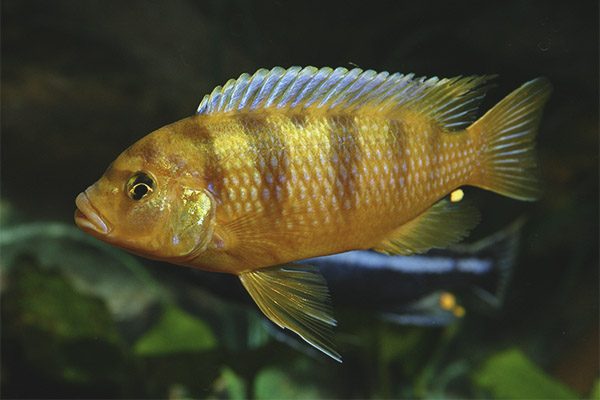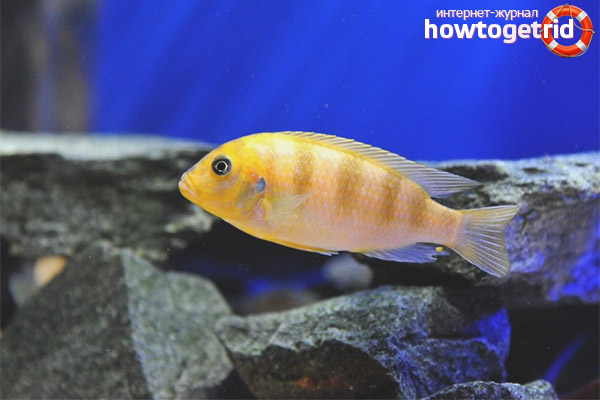The content of the article
Psevdotrofeus Lombardo has the Latin name Pseudotropheus lombardoi. This is a very beautiful aquarium fish, which belongs to cichlids. In nature, lives in a lake of Malawi. Experts refer it to the type of aggressive fish called mbuna.
Living in the wild, such a fish can grow up to 13 cm. When kept in an aquarium, it can be even larger. The peculiarity of the pseudotrofeus is that the male is outwardly significantly different from the female. Looking at them, you can decide that these are small fish belonging to two different species.
The male of this species has an orange color. On his back are soft dark streaks. The female is painted in a bright shade of blue. The stripes on the back are more pronounced. This feature distinguishes representatives of the species from other fish belonging to the mbuna, in which the males are blue and the females are colored orange.
Psevdotrofeus Lombardo refers to the most aggressive cichlids that originated from Africa. Therefore, to get these fish is recommended for those who have experience in maintaining aquarium pets.
They are particularly militant. This is characteristic not only of adults, but also of fry, which can kill a small guppy. In this regard, in the general aquarium they can not live. They can only coexist with other cichlids.
Habitat in nature
Food for representatives of this species is algae, which grow on stones, as well as plankton.
In nature, pseudotrophus lombardo can reach 12-13 cm. When the contents of the aquarium, they grow to large sizes.Live up to 10 years.
Content issues
Plant representatives of this species are recommended for those who have good experience in maintaining the aquarium. The main difficulty is that with other fish, except for the rest of the cichlids, it is simply impossible to settle them. Because of their aggressiveness, they can simply kill their small neighbors. In addition, for these cichlids, it is important to maintain all water parameters at a comfortable level for them. Water should be clean, not contain nitrates and ammonia.
Feeding
These fish are omnivores. Their main food in nature is algae, which grow on stones. When the aquarium content they can be fed not only live, but also artificial food. Basically, they should eat vegetable food. For example, it may be spirulina and various vegetables.
Content
If you want to keep cichlids in an aquarium, it is important to consider their need for space. For one male and two or three females, you must purchase an aquarium with a capacity of 200 liters or more. If you want, besides the pseudo-trophy of Lombardo, other cichlids live in the aquarium, the aquarium should be even larger.In their natural habitat, the water is alkaline, has a high level of hardness. Therefore, you can keep it not with all the fish, even if they are large. In addition, such conditions are not suitable for all algae. The water temperature should be high enough - 24-28 degrees. The pH should be between 7.8 and 8.6. If water in your region has other parameters, you will have to change its characteristics artificially. Some aquarists mix soil with egg shells. As the soil is best to choose sand.
These fish love to dig in the sand. If you plant the plants, they will dig them out, and also tear off the leaves. Therefore, with the maintenance of Lombardo plants in the aquarium is better not to plant. If you still want plants to be in the aquarium, you should give preference to tough species like Anubias. The advantage of sand as soil in an aquarium is that it is easy to siphon. Such a procedure should usually be carried out as often as possible. Otherwise, harmful substances will accumulate, to which the Lombardo is very sensitive. External filter should be powerful. Water should be changed every week.
It is important that in the aquarium were elements of decor that can serve as a shelter for the fish. Put there caves, snags, rocks. But you need to install the elements so that they fall when the soil is undermined by fish.
Compatibility
The ideal option for keeping these cichlids would be a combination of several females and a male. Aquarium for them should be very spacious. This is due to the fact that the male will behave aggressively towards his neighbors. He will even attack those fish that look like him outwardly. With other fish, they can not coexist. Psevdotrofeus Lombardo get along even with all the cichlids. For example, peaceful labidochromisov yellow should not be shared with them.
Sex differences
Breeding
Breeding fish of this species has an interesting feature. As soon as the female laid eggs, she immediately collects her in her mouth. It is there that fertilization takes place.The male pseudlotrophe on the anal fin has spots that the female accepts for its eggs. This is a kind of "cunning nature." The female is trying to peck them. In this way, the male is stimulated. It produces milt, which enter the female’s mouth where the roe is located.
In the aquarium, the male digs a hole that will serve as a nest. When the female has fertilized calf in the mouth, she hides in the shelter. At this time, the female stops eating. The eggs usually are about 50. The female carries them for about 21 days. When fry are born, they can feed on their own. You can feed them with daphnia or artemia. For the fry to survive among other fish, it is necessary to provide them with enough places for shelter.
Video: aquarium fish psevdotrofeus Lombardo












To send